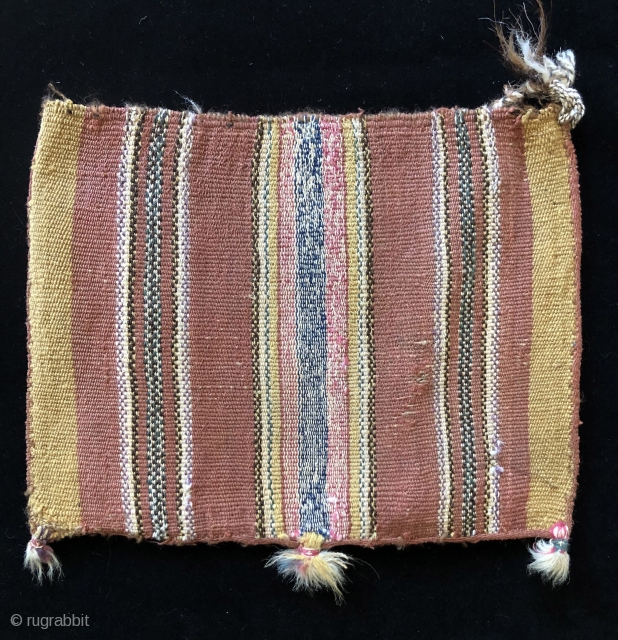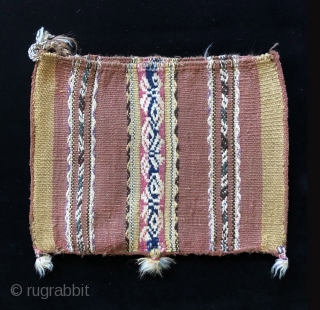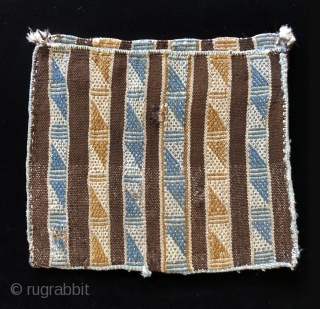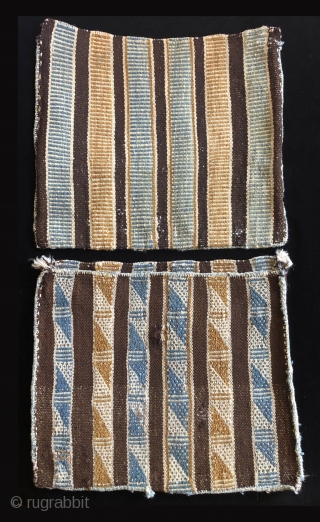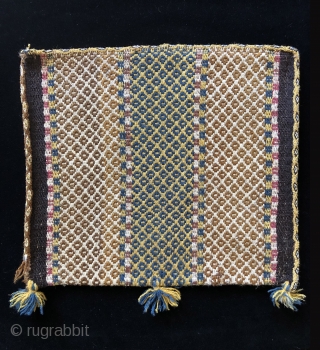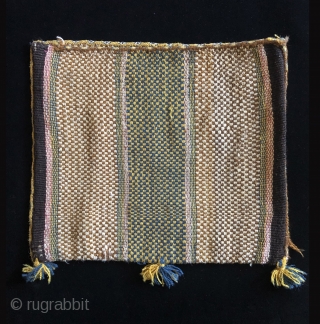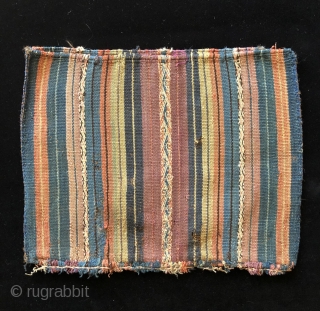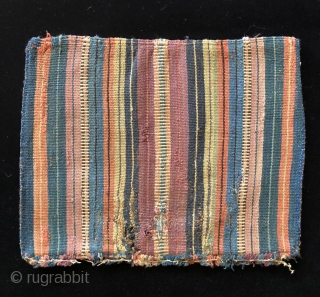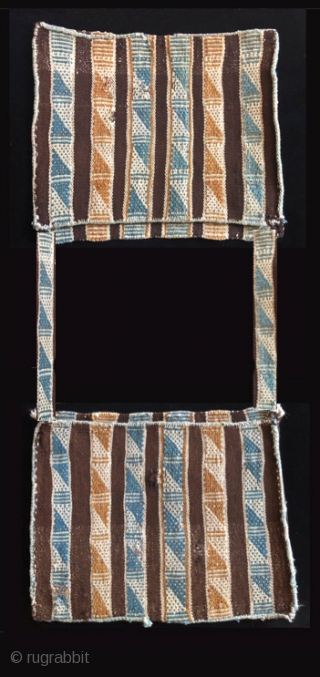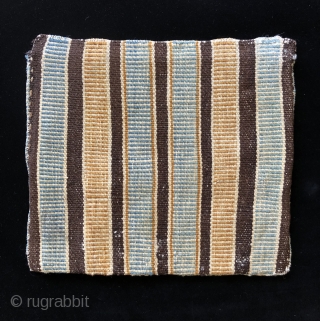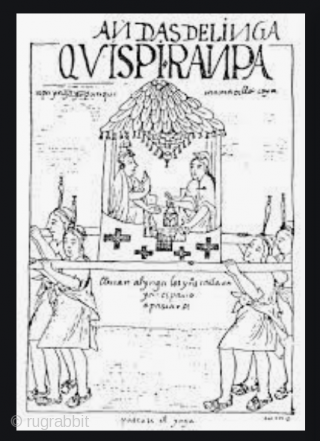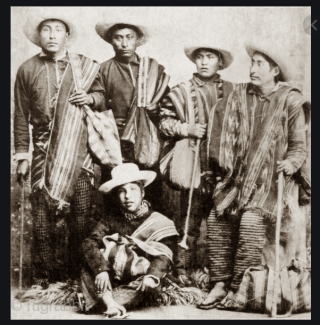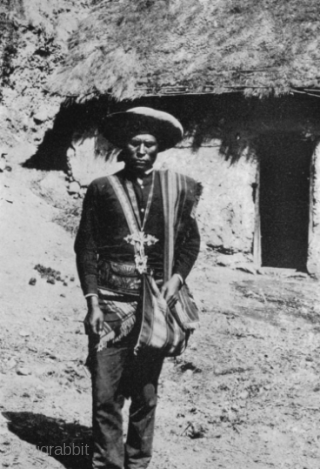- The Alforja – a Medicine Man’s Bag
There is another type of warp-faced bag woven by the Aymara of Bolivia that were made in sets of two - as a pair. These bags are called Alforja (al-fore-uh). Alforjas appear similar to coca bags (ch’uspas) but are usually substantially larger. There are not many of them as they were not made in nearly the same numbers as coca bags because of their very specialized usage. Always made in pairs, each bag was connected on each side of its opening with separately woven straps that allowed them to be worn either over the head - with one bag in front and one in back or over the shoulder. In a few rare cases the connecting straps are woven as part of the bag set, but almost always they are woven separately and sewn onto the bags. It has never been common to find old, 19th century alforjas that are still together as a set or with their original connecting straps extant. Many times they have lost their mated bag and only one bag remains. Complete sets with straps are quite rare. They are sometimes referred to as saddle bags, but were not made for use on animals. They were meant to be carried by highly esteemed Andean healers known as Kallawayas.
Coca bags and alforjas can sometimes be hard to distinguish from one another as designs found on coca bags can be similar to those on alforjas made in the same region. Alforjas were mainly woven in areas Northeast of Lake Titicaca. The defining characteristics of alforjas are their larger size compared with most coca bags, but the more telling difference is that Alforjas are always patterned differently on each face of the bag. The front face of an alforja is usually patterned with a graphic complimentary warp faced design while on the opposite side or back of the bag the design is discontinued and woven as a warp–faced plain weave. Since in rare instances, coca bags can be nearly large as alforjas, the design and structural difference between the front and back of such bags is the defining factor in determining whether a bag was made as a coca bag or an alforja.
Alforjas were made for and used by a unique ethnic group of indigenous indians who were traditional healers that spoke both Aymara and Quechua. They are said to be related to a Pre-Columbian Indian group known as the Mollo. These travelling medicine men, known as Kallawayas are recognized throughout the Andean region as highly skilled specialist healers. They were the physicians to the Inca rulers during the later Pre-Columbian period and before and they are still active to this day.
The Kallawayas used alforjas to hold the herbs, potions, fetishes and instruments used in their healing rituals. They also were known to carve special fetishes from white alabaster and other types of stone that were employed in healing and other rituals. (See other posts on my pages for some of these)
Included here are images of one set of alforjas and three individual alforja bags, all probably date to the first half of the 19th century or before. These are rare pieces and not easy to find on the market. The largest bag is approximately 16 x 14 inches and has an overall diamond lattice design on its face. The pair of bags with a light blue, gold and white pattern bands is missing the original, separately woven straps that once would have connected them - so i made a mock up of how it may have looked. The lovely, featured bag with the pastel tones shows a colonial period floral design in the central band - a sign of an early piece. All of these alforjas are unique examples, woven in different areas of the region. The bag with a blue ground is different from the others and may have been made outside the Kallawaya region. Shown are images of both sides of these alforjas to illustrate structural and design differences from front to back. (See also the 15th century drawing depicting Kallawaya healers who were awarded the great privilege of carrying the litter of the actual Inca ruler himself. a great honor given in recognition for their healing services to the Inca.)
- Home
- Antique Rugs by Region
- Category
- Profiles
- Post Items Free
- Albums
- Benaki Museum of Islamic Art
- Budapest: Ottoman Carpets
- Gulbenkian Museum
- Islamic Carpets. Brooklyn
- Islamic Textiles. Brooklyn
- Konya Museum: Rugs
- MKG, Hamburg
- MMA: Caucasian Carpets
- MMA: Mamluk Carpets
- MMA: Mughal Indian Carpets
- MMA: Ottoman Carpets
- MMA: Safavid Persian Carpets
- MMA: Turkmen Rugs
- McCoy Jones Kilims
- Ottoman textiles. Met
- Philadelphia Museum
- Rugs and Carpets: Berlin
- Seljuqs at the Met
- TIEM, Istanbul: Carpets
- V&A: Classical Carpets
- Vakiflar Carpets: Istanbul
- Baluch Rugs: Indianapolis
- Gallery Exhibitions
- Jaf an Exhibition
- Alberto Levi Gallery
- Andean Textile
- Christie's London: 2016
- Francesca Galloway
- HALI at 40
- ICOC Washington, DC 2018
- Jajims of the Shahsavan
- London Islamic Week April, 2018
- Mongolian Felts
- Navajo Rugs: JB Moore
- Persian Piled Weavings
- SF Tribal & Textile Art Show 2020
- SF Tribal 2019
- Sotheby's: C. Alexander
- Turkish Prayer Rugs
- Turkmen Main Carpets ICOC 2007










